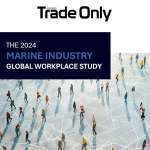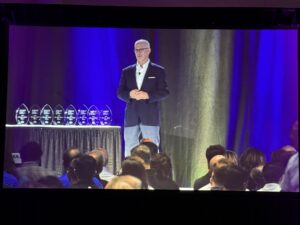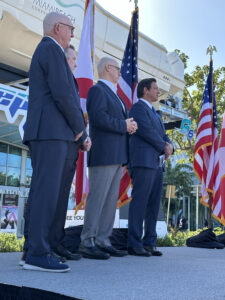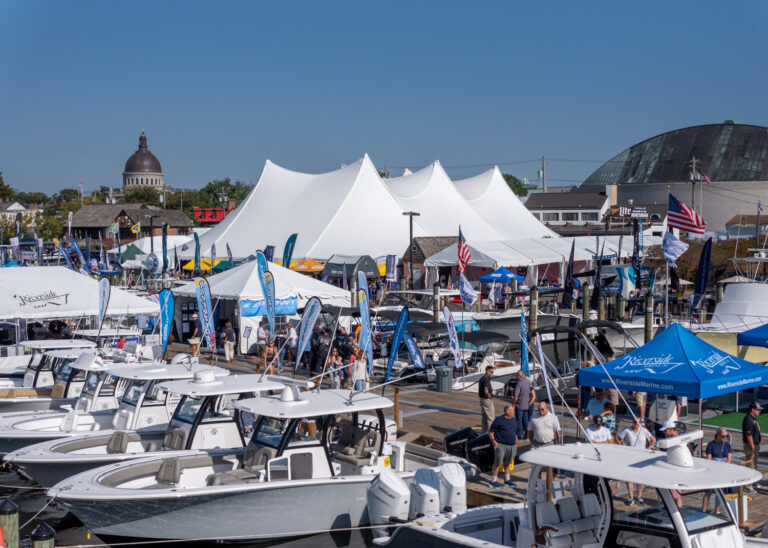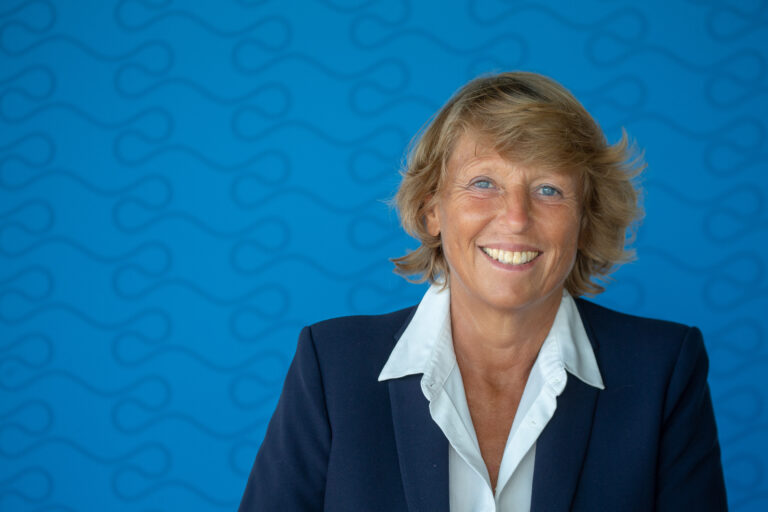Joe Lynch has spent a lifetime on the water, having learned how to sail dinghies in the U.K.’s Lake District at age 6. After college, he earned a handful of watersports teaching qualifications that drove him toward a career in the marine industry, starting with a position at a beach resort in Greece.
Lynch eventually took a marketing position at Neilson Active Holidays, and further developed his skills working with nonprofit and membership organizations before becoming chief executive officer of the International Council of Marine Industry Associations in 2023. Today, Lynch leads a six-person team that serves the organization’s 38 full and 57 sustaining marine industry members.
“Like many in our great industry, I would describe my career path as convoluted,” he says. “I think we need to do a better job of showing how many wonderful and varied opportunities are available to everyone, from all backgrounds and all entry points. As a customer-focused service and hospitality industry, it really is one of the few remaining meritocracies.”
We sat down in early January to discuss ICOMIA’s role in the global marine trade, decarbonizing the world’s recreational boat fleet and more. This interview has been lightly edited for space and clarity.
What can you tell us about yourself?
I’ve been involved in boating since I was 6 years old, when as a family we learned to sail small dinghies in the beautiful setting of the Lake District in the north of the United Kingdom. This grew into a lifelong love of being afloat. After school, I earned several watersports teaching qualifications that allowed me to carve out a path in the recreational boating industry. To this day, I still enjoy sailing and compete in coastal yacht racing throughout the year, now based on the South Coast of the U.K.
I graduated from college not knowing what I wanted to do, but secured dinghy sailing, windsurfing, yachting, powerboat and canoe teacher qualifications after leaving school. I jumped when I was offered the chance to spend the summer on a beach in Greece. I grew up in the North of England sailing on small lakes and ponds, so this was more exotic than I could ever have imagined.
Spending five or six years looking after guests and staff, and delivering memorable holiday experiences, I felt the need to settle down and unpack. I went to work at the headquarters of the company that went on to become Neilson Active Holidays. I learned that being able to understand the needs of a wide range of customers and help them choose the best experience was the foundation stone of all marketing. I still believe that principle is fundamental to the future success of leisure boating: How do we make it as easy and accessible as possible for customers to get the best experience on, in or around the water?
I then developed a specialty in marketing, especially around campaign analysis, digital marketing and e-commerce in a wide range of specialist travel and leisure activities, including coastal and inland cruising charter operators, with global distribution. The final pre-ICOMIA chapter was learning how to apply these principles in membership and not-for-profit organizations, where the focus is on the “multiple bottom line,” which is a great way of saying that we need to operate on a commercially sound basis, but that we are here not for shareholder return, rather for the greater good of our members or beneficiaries.
So when I saw the opportunity to play a part in ICOMIA’s future, it seemed like the stars had aligned, and thankfully I managed to convince our board of directors of the same. I’m incredibly grateful and humbled to be involved with such inspirational leaders, who all work tirelessly for the greater benefit of our industry.
Some 30 years later, I’m still in an industry I love and thinking that I should create a career plan at some point.
ICOMIA is not as well-known in North America as it is in Europe and Australasia. How do you describe it?
ICOMIA is the global voice of the industry. We are the umbrella organization that convenes and supports collaborations between national associations everywhere. Therefore, we work hard to ensure that our representation is truly global, independent of any one geography and creating value for our members wherever they may be.
I think that our profile is pretty consistent everywhere, but as we are the membership body of membership bodies, we don’t engage in much direct-to-business promotion or awareness-building. So, for example, our member the National Marine Manufacturers Association will always be much higher profile and the best way for most people in the United States to get involved. However, recent projects, such as “Propelling Our Future,” only made possible with the support and participation of the NMMA, the ICOMIA Marine Engine Committee and others, is helping to raise our profile. We are getting a lot more interest from people looking to be involved as a result.
How many organizations are under the ICOMIA umbrella?
Our memberships all fall into one of two types. Marine industry associations are those peak membership associations in their home markets, such as the NMMA, British Marine or NZ Marine from New Zealand.
The second types are our sustaining members, who join us directly to participate in working committees that focus on specific areas of development, such as marine engines or superyacht refits. In total, we have 38 full members and 57 sustaining members. Those full members represent countless other organizations on their behalf.
 PHOTO: GARY REICH
PHOTO: GARY REICHWhat is the biggest trade event that ICOMIA organizes each year?
We are lucky to be involved, by way of our membership, in so many events and shows around the world and throughout the year. The biggest purely trade show, though, by far is Metstrade held in November in Amsterdam. This show is brilliantly owned and organized by one of our strategic partners, the RAI, and we are proud to play a small part in the planning, promotion and content creation for the event.
The biggest trade event that ICOMIA and our members directly organize is the ICOMIA World Marinas Conference. This event represents the entire global community of marina management, ranging from the strategic design and finance aspects through operational and equipment suppliers, training providers and, of course, a heavy focus on sustainable operations. We are delighted that the 2025 edition for the ICOMIA World Marinas Conference will be held in the heart of Venice, Italy, in September. Having visited this location last year, I can’t think of a more fitting or inspirational setting for this conference.
What big projects will ICOMIA be working on this year?
The World Marinas Conference will be the jewel in the crown of our activities and probably the most visible event of the year. At the same time, we will continue to develop our “Propelling Our Future” campaign that we launched at the end of 2023 and updated just last month. This campaign is the biggest industrywide global collaboration that I think there has ever been. We worked with our members to commission this ground-breaking piece of independent, peer-reviewed, data-driven research that was tasked with helping us to understand the best options for decarbonizing our industry.
The results were an absolute game-changer, proving that there is no single solution that works for all use cases and boat or propulsion types. At the same time, a switch to sustainable liquid drop-in fuels could reduce our carbon emissions impact by up to 90%. All emerging technologies have a role to play, depending on the particular use case. We spent a year taking this message to our members globally, sharing the research and report at shows and trade events throughout the year. Huge thanks from us to many of your readers who made this work possible thanks to their membership in the NMMA, and to our other many supporters, including the press, who dedicated such detailed attention to helping us communicate this complex message.
We received such a warm and engaging reaction to this work that we very quickly realized that rather than this being a one-off piece of research, it is actually just the first step in a long journey whereby ICOMIA can act as the convener of ongoing research for years to come, as we all strive to build our knowledge and to implement the very best sustainability practices.
 PHOTO: SCHARFSINN86 - STOCK.ADOBE.COM
PHOTO: SCHARFSINN86 - STOCK.ADOBE.COMAs an example, when we launched “Propelling Our Future,” which showed for the first time the carbon impact of nine different boat types based on full cradle-to-grave analysis and firsthand average-use cases, everyone wanted to know the “what if” scenarios. We were therefore delighted to launch our “Tipping Point” analysis at Metstrade [last] year, to show when it makes sense to switch between propulsion options, based on individual use cases. We will continue to build on this body of research and make all such findings available to our industry. We also plan to extend the scope of such analysis to study more environmental factors, as well.
Tell us more about that “Tipping Point” analysis.
It is designed to show the sensitivity between the propulsion options, the likely hours of engine use and the resulting carbon impact over the life of the product. For example, our initial findings showed that a pontoon boat used for a typical 35 hours per year over a 38-year lifespan would benefit with a 60% reduction in global warming potential by switching to sustainable liquid fuels.
A purely electric version of the same boat would need to increase its annual usage by 190% to achieve the same benefit. The tipping point of getting the optimum benefit for global warming is for use cases with nearly twice as much annual utilization. For a displacement motorboat, this is as high as 595%.
It’s a great way of demonstrating that because our industry has unique characteristics with low annual utilization and very long product lifespans, we must be considered separately to most other decarbonization assumptions.
Boats make up such a small percentage of carbon emissions. Why is it important that we decarbonize?
Everyone who loves boating loves the places we go boating in. We all instinctively want to protect these special places and to preserve our access to their benefits for generations to come. It is only fair that we accept this responsibility and play our part in building a sustainable future.
We also want to be leading this move and helping the industry, and all associated regulators, to make decisions and policy based on scientific research and hard data. If we do not demonstrate that we are acting responsibly and finding innovative pathways to sustainability, there is a chance we could get caught up in policy or regulations based on anecdotes or imprecise opinions that could accidentally lead to negative outcomes.
There’s a mixture of concern and disbelief about climate change in the United States. What’s the perspective on your side of the globe?
In all the meetings I’ve been to, wherever we have presented our research and in all of the workshops and committee meetings I’ve attended, there has only ever been unanimous support for a more sustainable future for boating. Increasingly, people don’t see this as an either-or choice, nor a compromise of the enjoyment or demand for boating. We all want a sustainable future for boating in every sense of the word.
What is the most challenging aspect of your position?
We feel blessed that the challenges we face are all positive ones. We know that the potential for support and value that we can provide to our members is many multiples of the status quo. The prevailing challenge is how we prioritize the opportunities according to the resources available and grow our capacity while maintaining a ruthless focus on adding value to all of our members.
And the most rewarding aspect?
On a personal level it’s great to be able to spend the workweek talking about subjects that match my own passions. Helping people to access the benefits of time on or close to the water, and building a more sustainable future is another.
On a professional level, I keep pinching myself as I get the opportunity to travel to and meet some of the most inspirational, expert and iconic people and places. I’m constantly reminded about how lucky we are to be working in such a collaborative, open and supportive industry, where everyone naturally understands that through collaboration, we can all build a better future for us all to enjoy. It’s an amazingly refreshing and energizing culture to be part of.
What sorts of macroeconomic headwinds are ICOMIA members facing?
The membership of ICOMIA is so diverse in terms of geography, market development, regulatory landscapes and even boating culture that it’s hard to identify truly global trends. I think the most consistent factor is just as we thought we had come to terms with the new post-Covid normal, global economic factors have made life harder. Inflationary economies with the associated higher costs of borrowing have made a noticeable negative impact on demand, especially at the lower-to-mid price points, where manufacturers are most likely to be selling to private buyers looking for some financing.
How was 2024 for international marine industry companies?
Since autumn onward, there have been more reports of cautious optimism and signs of recovery as people start to feel more confident about the economic outlook. At the same time — and as detailed in the ICOMIA market statistics book — we continue to see a very positive correlation between innovation and demand. Any new and customer-focused developments help drive demand. It may be a comfort-focused design feature, an automated navigation and docking system, a new sustainable and cost-efficient propulsion technology, or simply a cool, fun feature. They all stimulate demand.
What are some highlights from last November’s Metstrade show?
It’s hard to pin down one event as the highlight. Instead, it is the overall atmosphere, the excitement of an industry coming together. The range of innovative products showcased in the DAME Design Awards is always fascinating and reminds me of how quickly our industry innovates and evolves. Above all, I think it is the highlight of our year of member engagement, when we have the chance to meet up, to work with and to socialize with our members from all over the world.
Globally speaking, what are your thoughts on the cost of entry for new boaters?
I think we still have a lot of work to do as an industry to promote just how accessible our industry is and to challenge the common misconception that you need to be a multimillionaire to access the many benefits of boating. Of course, owning and running a superyacht requires significant resources, but that is just a tiny piece of the total puzzle. I know from personal experiences that access to boating need not be expensive. It’s also fascinating to see the growth in the business models of fractional or shared ownership, and the proliferation of the boat-club model.
Thinking back to my point about how best to market our industry, we need to remember that it is more than just cost that is a potential barrier. Such innovative models not only remove price barriers, they also eliminate the cost, time, skills and confidence barriers for maintenance, restrictive choices and of commitment to a particular boat.
There is a possibility that new tariffs could potentially affect exports from your members’ businesses into the U.S. market. Is this a concern among your members going into 2025?
Anything that could become a barrier to trade is a concern for all of us. We are a truly connected global industry, importing and exporting components, skills and finished products across international borders. This is a key area where ICOMIA works hard to support our members with our lobbying and political-engagement strategies.
Regulatory overreach is a common concern in the U.S. marine industry. Are you seeing anything similar elsewhere?
Without question, maintaining access to our precious watery spaces is important. Access can be threatened by regulatory overreach or many other factors, including commercial or regulatory pressures on that valuable coastal real estate. I think the closest parallel to the whale speed limits on the U.S. East Coast are the measures being introduced in the Mediterranean to protect seagrass from damage caused by anchoring of vessels. We are working hard to promote the growth of sustainable mooring options that will preserve this valuable ecological resource while also preserving the many social and economic benefits that boating delivers to the areas.
What is your favorite part of working in the marine industry?
This is probably the easiest question to answer: It’s the people. We are lucky to work in an industry focused on delivering pleasure in beautiful parts of the world, but what makes it so special is that we all get to work with such great people. Supportive, open, collaborative and genuinely keen to make a positive difference. I can’t think of a better industry to be involved in.
Is there anything you’d like to add?
Just to say thank you for giving me this opportunity to explain more about the work of ICOMIA and to thank your readers for all their support, either directly or via their membership in NMMA.

